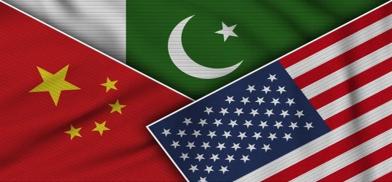Battle to dominate global communications: Pakistan should leverage US-China rivalry for national benefit
For South Asia, particularly Pakistan, this fragmentation poses challenges but also opportunities. Pakistan’s strategic investments in its digital infrastructure, supported by both Chinese and Western technologies, could position it as a bridge between these emerging digital spheres. By fostering regional connectivity and digital cooperation, Pakistan can mitigate the risks of fragmentation and ensure that its digital economy continues to thrive in a multipolar world.

In the intensifying competition between the US and China, the control over global telecommunications infrastructure, particularly undersea cables, has become a key strategic arena. This technological rivalry has profound implications not just for global power dynamics but also for regions like South Asia, where countries such as Pakistan are navigating the complexities of this new geopolitical landscape with a focus on national development and strategic autonomy.
Undersea cables are critical for global communications, carrying nearly 95% of international internet traffic. While the US has historically dominated this space, China’s rapid expansion, particularly through its Belt and Road Initiative (BRI), is reshaping the landscape. China’s investments in undersea cable networks aim to enhance global connectivity, particularly in regions that have been underserved, offering new opportunities for economic growth.
US-China Tech Rivalry
The US government’s concerns about China’s involvement in undersea cable projects stem from fears that Beijing could leverage its control over these networks for strategic advantages, including intelligence gathering. In response, the US has sought to curb China’s influence by encouraging allies and partners to avoid Chinese technology in critical infrastructure projects. This rivalry is as much about economic dominance as it is about national security, with the US warning that Chinese control of communication infrastructure could pose significant risks.
China, on the other hand, argues that its investments are aimed at improving global connectivity and fostering economic development, especially in the Global South. For many developing nations, Chinese infrastructure projects offer much-needed investment in critical sectors that have long been neglected by Western powers.
Pakistan: Balancing Relationships
South Asia, a region with immense strategic importance and digital growth potential, finds itself in a unique position in this rivalry. Countries like Pakistan, with its strategic location and growing digital infrastructure, are leveraging these developments to enhance national connectivity and economic resilience.
Pakistan, a key player in South Asia, has skillfully managed its relationships with both the US and China, ensuring that it benefits from investments while safeguarding its sovereignty. Pakistan’s inclusion in China’s BRI has brought significant infrastructure projects, including undersea cables, which are vital for enhancing its digital economy. These developments are not just about economic gains but also about positioning Pakistan as a regional hub for digital connectivity.
Rather than viewing Chinese investments through a lens of dependency, Pakistan has embraced them as opportunities to diversify its economic partners and strengthen its infrastructure. The country’s strategic autonomy in navigating this complex landscape allows it to engage with global powers on its terms, focusing on national development and regional stability.
India and Bangladesh: Diverging Paths
India, another significant player in the region, has taken a cautious approach, aligning closely with the US in its digital infrastructure decisions. This alignment reflects India’s broader geopolitical strategy but also presents challenges as it balances its economic aspirations with security concerns. Bangladesh, meanwhile, has benefited from Chinese investments but is also exploring ways to maintain a balanced relationship with global powers, ensuring its long-term growth and stability.
The Risk of a Fragmented Internet
One of the most concerning potential outcomes of the US-China tech rivalry is the fragmentation of the global internet. As the US and China build parallel infrastructures, there is a growing risk that the global internet could splinter into separate, incompatible networks. This so-called “splinternet” could have severe implications for global commerce, communication, and cultural exchange.
For South Asia, particularly Pakistan, this fragmentation poses challenges but also opportunities. Pakistan’s strategic investments in its digital infrastructure, supported by both Chinese and Western technologies, could position it as a bridge between these emerging digital spheres. By fostering regional connectivity and digital cooperation, Pakistan can mitigate the risks of fragmentation and ensure that its digital economy continues to thrive in a multipolar world.
As the US and China vie for control over the world’s telecommunications infrastructure, South Asia, with Pakistan at the forefront, is navigating this new Cold War with a focus on strategic autonomy and economic development. By carefully balancing relationships with global powers and investing in its digital future, Pakistan is not just surviving but thriving in this high-stakes game of technological dominance. The decisions made today will shape the region’s future, and Pakistan’s leadership in this domain could set a precedent for how smaller nations can leverage global rivalries for national benefit.
(The author is an Islamabad-based researcher, did her MPhil from National Defence University (NDU) in Strategic Studies and her BSc from University of London (UOL) in International Relations. Views are personal. She tweets by the handle @rushmeentweets and can be reached on sehrrushmeenwrites@gmail.com )









Post a Comment